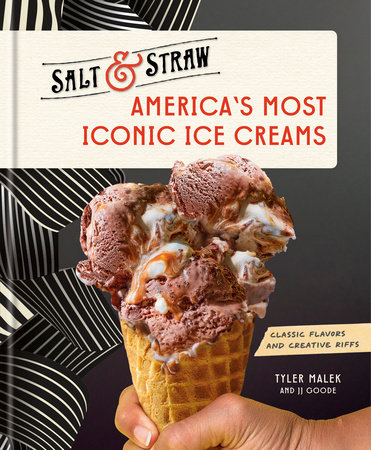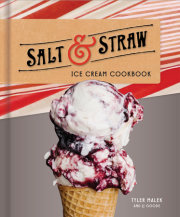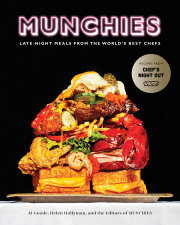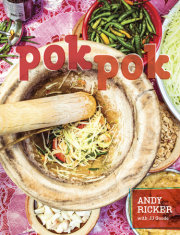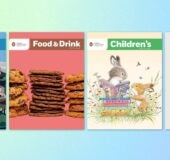How the Flavor Journey BeganLong before Salt & Straw was the biggest small-batch ice cream company in the world, it was just twenty-three-year-old me, my brilliant cousin Kim, and an erratic freezer in Portland, Oregon. Then a cup of coffee changed everything.
I had just quit my job as the world’s kindest and least effective car salesman (don’t ask) and convinced Kim to consider me for the position of head ice cream maker for the shop she planned to open in Portland. Minor detail: I had never made ice cream in my entire life. So an hour later, I walked into a Goodwill in Seattle, bought four $4 ice cream makers, and started experimenting. After a week of maxing out the machines, I had recipes for thirty flavors and sent them to Kim. Because of (or perhaps despite) the unlikely inspirations I dreamt up—grapefruit with sage, coffee with bone marrow—she agreed to give me a shot.
I moved into Kim’s basement and enrolled part time in culinary school. I figured maybe I should know something about making food before I got into the business of, well, making food. In the morning, I attended classes. In the afternoon, I went to a commissary kitchen to test out flavors for our fledgling ice cream operation. And on the way to the latter, I’d take my notebook to a coffee shop for a cup and a think.
This was Portland in 2011, so that shop happened to be Stumptown Coffee’s The Annex. Back then, Stumptown wasn’t yet a household name and an emblem of direct-trade and culinary artisanship. It was still just a neo-punk outfit making waves for its revolutionary sourcing practices and exceptional coffee. Or at least, what I’d heard was exceptional coffee. At the time, I didn’t know good coffee from the Folgers crystals my culinary school professor used to make tiramisu.
In your wildest, most
Portlandia-inflected dreams, you couldn’t have imagined the scene at The Annex. Behind the counter was a small army of baristas, their long mustaches waxed, their bodies covered in flash tattoos. The menu on the wall listed no dark roasts or Frappuccinos but eighteen single-origin coffees and six brewing techniques, including but not limited to those enabled by the Seussian contraptions—multichambered glass beakers, squiggly tubes, and the like—on display. When you approached the counter to order, you’d get a long spiel about the various beans and then another about the pros and cons of the different brewing techniques. Fifteen minutes later, you’d have a cup of coffee. The process was ludicrous, condescending, and impractical. I absolutely loved it.
The height of absurdity came when I stumbled upon a cupping. When a novel bean arrived at The Annex, meticulously sourced and locally roasted, the baristas would have a formal tasting (a cupping, in coffee-industry parlance) and invite anyone in the shop to participate. Babyfaced and still in my checkered culinary school pants, I lined up behind the city’s bewhiskered baristas and Third Wave coffee geeks, trying to memorize the ritual I watched them perform—pour, wait, crack, skim—before they had their first tastes, each one punctuated by an ostentatiously loud slurp.
Then I listened as they discussed the flavors of the different coffees. The existence of those two plurals blew my mind. First, I hadn’t known there were
coffees—thousands upon thousands of varieties of plants that produce the fruit that gives us coffee beans. Second, I didn’t realize coffee had
flavors. To be honest, I thought coffee was a flavor—a single bitter, vaguely chocolatey profile. How wrong I was.
Over the course of a year, I tasted more than one hundred different coffee beans, many of them brewed in multiple ways. By the end, simply ordering a cup of coffee seemed as silly as going to a restaurant and asking for a glass of grape wine. I learned that I loved Guatemalan El Injerto brewed as a pour-over and served with a dash of simple syrup to play up its notes of cherry. That Indonesian Gajah Aceh brewed as espresso was my personal favorite, its intense chocolatey flavor tinged with blackberry and tobacco heightened with a generous splash of cream and two big spoonfuls of sugar.
It’s hard to explain how profoundly this experience affected me. I quit school. I scrapped those first thirty flavors, which I’d scribbled down while sipping a caffè latte at a Seattle Starbucks. I began to let curiosity be my guide. Suddenly, every ingredient, every basic, familiar pleasure seemed to have secret potential, its own universe that I had never imagined. If I had been in the dark about coffee, even as a student in culinary school who was supposed to be learning about food, what else was I missing?
So, so much, it turns out. Once I knew to look, I found revelation everywhere. I sampled salt crystals of various shapes, colors, sizes, and flavors with Mark Bitterman, author of a manifesto on the delectable mineral. I discussed orchid pollination with Bill and Marty of Singing Dog, the Stumptown Coffee of Papua New Guinea–grown vanilla beans. Suddenly, I felt like I was looking through a powerful telescope after years of standard sky-gazing: each ingredient, once a single faint star, was now revealed to be a brilliant constellation.
And it made a huge difference in my ice cream making. Just as they do for cooking, great ingredients massively upgrade your frozen treats. But for me, learning about the particulars of coffee and chocolate, vanilla and spirits, nuts and tea from various local artisans and gurus ultimately did more than just elevate the ice creams I wanted to make. It inspired them. Before my Stumptown conversion, for example, I might have set out to make a great coffee ice cream. But now that I knew coffee was an entire galaxy and not a single planet, I began to hobnob with roasters, baristas, and coffee growers and ultimately designed coffee ice creams (more than twenty to date) in order to showcase the qualities unique to each bean. The more I learned about ingredients, the better my ice cream became.
Copyright © 2025 by Tyler Malek and JJ Goode. All rights reserved. No part of this excerpt may be reproduced or reprinted without permission in writing from the publisher.





